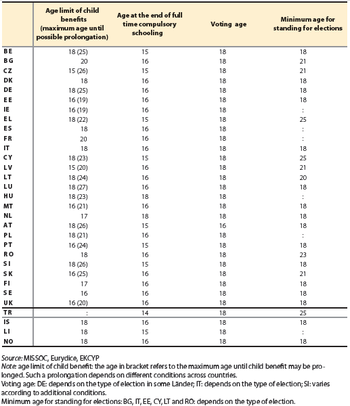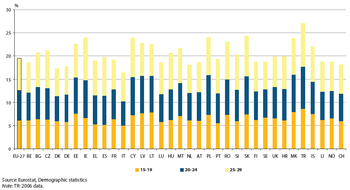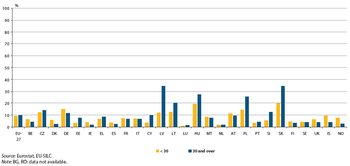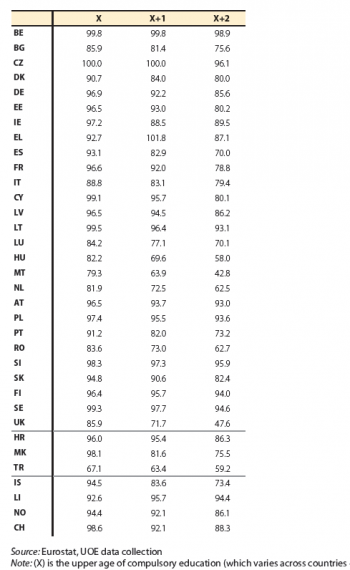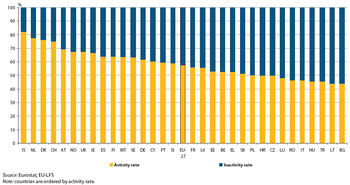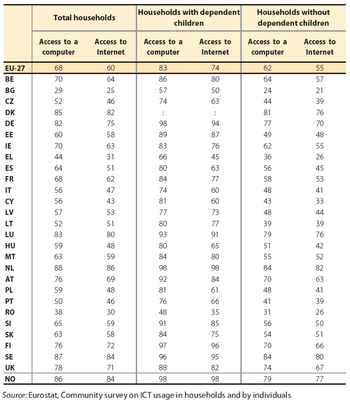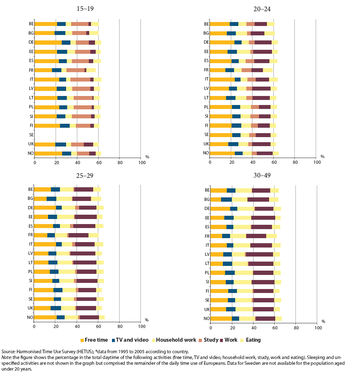- Data from July 2009. Most recent data: Further Eurostat information, Dedicated section.
This article presents recent statistical data on the young in the European Union (EU). Overall, young people represented just under a fifth of the EU population in 2007. At national level, the most ‘youthful’ nations in the EU included Ireland, Cyprus, Slovakia and Poland, each with more than than 24 % of young people; in Denmark, Germany and Italy, on the other hand, young people accounted for less than 18 % of the population. Youth and their elders are facing two demographic challenges: the ageing and the impending decline of the European population.
The article briefly discusses demographic situation and trends, family situation, income and living conditions, health, education and labour market situation, computer and internet connectedness, and lifestyles. A thorough and much more detailed analysis can be found in the publication Youth in Europe.
Main statistical findings
Demography
Growing old... still staying young
In 2007, the European Union counted around 96 million young people aged between 15 and 29 years. These young people and their elders are facing two demographic challenges: the ageing and the impending decline of the European population. In fact, according to projections, by 2050 the population aged under 15 will account for a quarter of all persons of working age (15–64) and for half of the population aged over 64.
Overall, young people represented just under a fifth of the EU population in 2007. At national level, the most ‘youthful’ nations in the EU included Ireland, Cyprus, Slovakia and Poland, which counted the highest proportion of young people in the total population (more than 24 %). By contrast, in Denmark, Germany and Italy young people accounted for less than 18 % of the population.
International migration has become an important driver of European population growth. However, the available data to monitor this phenomenon are still difficult to analyse since no criterion (e.g. citizenship or residence) perfectly captures international mobility. Among the EU Member States for which data are available, Spain, Austria and Germany recorded the highest shares of foreigners among the young population aged 15–29 (representing respectively 15 %, 14 % and 12 %).
Family situations
Leaving the parental nest, getting married and having children: there’s no hurry
The path from childhood to independent adulthood is lined with a number of crucial milestones and decisions, such as leaving the parental home to study or to work, moving in with a partner, getting married and having children. However, this road is not a one-way street; difficulties in securing a steady job or sufficient income and the dissolution of the couple or family may force young people to return to the parental home. In 2007, young women generally tended to leave the parental home earlier (by one or two years) than young men but strong disparities were noted across countries. Indeed, women tended to leave the parental nest at the average age of 22 in Finland, and 29 in Italy, Malta, Slovenia and Slovakia. For young men, the average age ranged from 23 to over 30.
Material reasons were often put forward when young Europeans were asked via opinion polls why they or their peers tended to delay leaving the parental home. In fact, 44 % of young Europeans (aged 15–30) consider that young adults cannot afford to leave the parental home and 28 % agree that not enough affordable housing is available. However, in some countries, more than 20 % of young respondents consider that remaining with their parents allows them to live more comfortably with fewer responsibilities.
In 2006, first marriages usually involved women younger than 30 in a majority of countries. As concerned men, in nearly half of the countries, a majority of first marriages concerned men older than 30. For women, getting married below 20 years of age is a relatively rare phenomenon in European countries, except for Romania and Turkey.
Despite a recent upturn in the average number of children per woman in several Member States, the highest national fertility rates noted in the EU are still beneath the replacement level. The average age at which women have their first child ranged from 25 to 30 and has increased in all Member States over the 1995–2005 period. In a majority of countries, more than half of first births took place after the age of 25 when considering first-time mothers aged 15–29. In Germany, Spain and the United Kingdom, first-time mothers over 30 were even more numerous than their younger counterparts.
Income, living conditions and health
Living on a shoestring?
In 2007, 20 % of young Europeans aged 18–24 were at risk of poverty — i.e. living in households who had at their disposal less than 60 % of the median equivalised income of the country they live in. Moreover, the average income of young people aged 16–24 was much lower than that of their elders aged 25–49, as young people still in education either have not started working or are at the beginning of their career. In 2007, less than 10 % of young European households (the oldest member of which is aged under 30) were unable to afford a meal with meat or fish every second day and to buy a computer, and one in six were unable to afford a car. Finally, one third of them could not afford one week’s holiday away from home per year.
Young people can expect to live longer than ever before, but death keeps no fixed timetable In 2006, more than 90 % of young Europeans aged 15–24 felt that they were in ‘good’ or ‘very good’ health. In fact, young people can expect to live longer than ever before, with life expectancy at birth ranging in the EU from 71 years in Latvia to 81 years in Spain, France and Sweden. However, young Europeans are also more likely than their older counterparts to die as a result of transport accidents, suicide, drugs and AIDS. Young men aged 20–24 tended to be more affected by transport accident and intentional selfharm than young women. In 2006, nearly 30 % of new HIV cases were diagnosed among young people aged between 15 and 29, almost two thirds of which (60 %) concerned those aged between 25 and 29.
Smoking, drinking alcohol and taking drugs are detrimental to health. In most countries, the proportion of daily smokers increases until the age of 45 and young men are usually more likely to smoke than women. According to the survey, Europeans had their first episode of drunkenness at the age of 13 or 14; and in most European countries more than 80 % of young people aged 15 or 16 had consumed alcohol at least once in the past 12 months. Moreover, in more than half of the countries considered, more than 40 % (but usually less than 50 %) of young people aged between 15 and 16 years declared that they had been drunk at least once in the past 12 months.
In 2004, most young people agreed that getting hold of drugs was not difficult at parties, in pubs and nightclubs as well as in their neighbourhood and at school. Young people also considered that the main reason to try drugs was curiosity, followed by peer pressure and thrill-seeking. Less than 20 % of the 15 to 34-year-olds have taken cannabis, which was the most popular drug in all countries for which data are available.
Education
Preparing for the future rather than fulfilling a legal obligation
In most European countries, compulsory schooling ends between the ages of 15 and 17, but it is usual to remain in education thereafter. Although participation rates in education tend to decline in all countries after the end of compulsory education, they remain above 80 % in most European countries one year after the theoretical age at which compulsory schooling ends, especially for women.
At EU level, the number of young men and women in upper secondary education is fairly similar, but girls generally outnumbered boys in general programmes, whereas the opposite is true in vocational programmes. This gender gap is also reflected in tertiary education: women were usually more numerous than men in the first stage of tertiary education (ISCED level 5) and especially in certain fields of education (education, humanities and arts). The reverse was usually true in the second stage of tertiary education (ISCED level 6).
In 2006 there were nearly 19 million tertiary students in the European Union, and 15 % of the population aged between 18 and 34 attended tertiary education. The median age of tertiary students varied widely across Europe, from 20 years in Greece to 26 years in Iceland.
The ability to communicate in more than one language is a desirable skill for all young people, regardless of the educational programme orientation. In 2006, less than 10 % of pupils in upper-secondary education were not learning a foreign language. Nevertheless, pupils in vocational programmes tended to learn fewer foreign languages than their counterparts in general programmes.
Despite the overall increase in the educational attainment level of young generations compared to their elders, some young people with only lower-secondary education are still at a disadvantage: the share of early school leavers has declined slightly in the EU from 2000 onwards to reach 15 % in 2007, but young men are still more affected by this phenomenon than women.
Although social mobility is often a reality in the Member States, success in education still appears to be influenced by the educational level of the parents. Young people whose parents have completed at most lower-secondary education more often reached lower- or upper-secondary education than tertiary education. At the other end of the spectrum, young people with tertiary educated parents tended more often to reach and succeed in tertiary education than their peers from lower educational backgrounds.
However, stronger competition requires people to continually update their skills over their entire life: lifelong learning is thus seen as a key factor in securing employment rather than a job. Participation rates in non-formal education and training were slightly higher for young people under 30 than for their older counterparts. But it is noticeable that tertiary educated young adults usually participate more in non-formal education than their peers with a lower educational attainment level.
Labour market
From school benches to working life: many roads lead to the labour market
Leaving formal education (either school or university) is a crossroad in life requiring young people to decide either to enter the labour market or to be inactive. The path to the labour market can be straightforward (from formal education directly to full-time permanent employment or to inactivity) or more fragmented (combining schooling with part-time work and/or seeking work or alternating inactivity and work and/or seeking work).
Such diversity in patterns of transition from education to work is especially apparent among the population aged 18 to 24 years: in 2007, at EU level, 59 % of young people aged 18 were exclusively in education or training and only 13 % in economic activity. By the age of 24 the proportions were reversed. Moreover, 20 % of Europeans aged 18 and 16 % of those aged 24 combined education or training with economic activity.
The employment rate increases with age. In 2007, it ranged from 37 % (for those aged 15–24) to 75 % for those aged between 25 and 29 years. But being employed does not mean that young people are no longer eager to study and learn: 14 % and 12 % of young employed Europeans aged 15–24 and 25–29 respectively were still either studying or in training. A broad spectrum of results in terms of youth unemployment rate was reported in the EU Member States: in 2007, youth unemployment rates ranged from 8 % to more than 20 %. Moreover, in all Member States, young people tended to be more affected by unemployment than their elders. This pattern tends to be exacerbated by the current economic crisis. Indeed, the youth unemployment rate is increasing strongly in nearly all European countries: in the year to the first quarter of 2009, the unemployment rate of young people aged 15–24 increased faster than that of their elders aged 25– 59.
Most young people in employment were employees but not all fulfilled their desire of having a full-time permanent job. Indeed, 37 % of temporary workers aged 15–24 and 65 % of temporary workers aged 25–29 had a fixed-term contract because they could not find a permanent job. In contrast to temporary work, a majority of working young persons aged 15–24 chose to work part-time in order to pursue their studies, which could explain why the share of part-timers is higher among the 15 to 24-year-olds than among the 25 to 29-year-olds.
Aside from temporary or part-time employment, young people may also work atypical hours by necessity or in order to better combine education and work. At European level, working on Saturdays was the most common type of atypical working hours for young employees. In fact, 51 % of employees aged 15–24 (35 % of whom were still in formal education) worked on Saturdays either sometimes or usually. In 2007, nearly 60 % of employed persons aged 15–24 were occupied in four economic sectors: ‘wholesale and retail trade’, ‘manufacturing’, ‘construction’ and ‘hotels and restaurants’. Among these four sectors, young people still in formal education represented from 25 % (construction) to 44 % (hotels and restaurants) of all employed people aged 15–24.
Computer and internet
A new way of interacting with the world
Young people are at the forefront of the technological revolution and the presence of dependent children in the household seems to increase the prevalence of computer and internet access at home.
The share of daily computer and internet users has increased over the past five years in all age groups, but the gap across generations has remained stable. In 2008, more than 70 % of those aged 16–24 used a computer daily and 66 % used the internet every day or almost every day, mostly from home and from the place of education.
E-skills can be considered as a key competence that can contribute to a successful life in a knowledge-based society and there is an obvious gap between computer skill levels of younger and older generations. In 2007, 41 % of Europeans aged 16–24 were able to carry out five or six computer-related activities, against only 18 % of those aged 45–54. Young generations (aged 16–24) have integrated the Internet into their day-to-day life as a communication tool, e.g. using search engines to find information (86 %), sending emails with attached files (77 %) or posting messages on chat rooms (61 %). More technical competences were less common — for instance, only 25 % of people aged 16–24 were able to create a web page. At EU-27 level, young people aged 16–24 declared that they acquired their e-skills mostly through self-study (72 %), informal assistance (65 %) and formal education institutions (65 %).
Among the wide range of internet activities, more than 80 % of the population aged 16–24 accessed the internet to communicate, to search for information, to use online services and for leisure activities. The distribution of internet activities did not change significantly over the past years. Although young women and men showed similar interest in most activities (such as e-mail exchanges, use of advanced communication services, etc.), major gender disparities emerge when considering leisure activities (which men are more interested in) and the search for information on health, education and training (which women are more interested in). Compared to their elders, young people aged 16–24 less frequently ordered goods and services over the Internet; films, music, clothes and sports goods were widely sought after on the internet by young people.
Lifestyles
Life is not all hard work
In most countries, leisure time (excluding TV and video) accounted for more than 20 % of a normal day of 15 to 19- year-olds. As people get older, this share tends to decrease as the gradual shift to working life leaves less time for leisure. Leisure time can be used to partake in enriching cultural events such as the cinema, live performances, live sports and cultural visits. At European level, more than 82 % of 16 to 24- year-olds went to see at least one film in the reference year; this share was twice high as for people aged 30 and over. In contrast, only 56 % of Europeans aged 16 to 24 went to see a live show. Less than half of young Europeans went on a cultural visit during the reference year; this was also the case when considering attendance at live sports events.
Young people often feel the need for adventure as travelling has always been a source of knowledge and personal development. Available data on tourism are difficult to interpret since the data distributions by age make no distinction between young people travelling on their own and with their parents. Broadly speaking, the age distribution of tourists corresponds approximately to the age distribution of the total population, but in most of the new Member States (2004 and 2007 enlargements) tourists aged 15 to 24 years accounted for a relatively high share of the tourist population. However, the average number of holiday trips per tourist as well as the destinations of tourists (domestic and/or abroad) did not reveal significant differences between age groups.
In their everyday life young people have different opportunities to make their voices heard or to participate in community life. In 2006, recreational groups and religious organisations were the most popular types of community engagement among European youth: 27 % of young men aged between 16 and 29 (against 19 % of young women) took part in recreational groups and 16 % of them (against 20 % of young women) took part in church or other religious organisations. At the other end of the spectrum, less than 4 % of young Europeans participated in the activities of political parties or trade unions.
Aside from a generational gap (36 % of people aged 30 and over declared being quite interested in politics compared to only 26 % of 16 to 24-year-olds), interest in politics also reveals gender differences: relatively more young men declared that they were interested in politics compared to young women. This rather limited interest in politics is shared by all age groups and is accompanied by a limited trust in politicians and national parties and, to a lesser extent, in national parliaments. Nevertheless, most people aged 16–29 and 30 and over trust the European Parliament.
Finally, young Europeans are more optimistic than their elders when picturing their life in 20 years’ time: 47 % of 15 to 24-year-olds expect life to get better and young people especially believe that work opportunities for men and women will be more equal and that access to education will be easier in the future.
Data sources and availability
This article covers the European Union (EU) and its 27 Member States. Where data availability permits, information is also included for the candidate countries Croatia (HR), the Former Yugoslav Republic of Macedonia (MK) and Turkey (TR), and for the EFTA countries Iceland (IS), Liechtenstein (LI), Norway (NO) and Switzerland (CH).
The main data sources used for this publication are Eurostat databases: Demographic statistics, the European Labour force survey (EU-LFS), the EU statistics on income and living conditions (EU-SILC), Health statistics, the UNESCO-OECD- Eurostat (UOE) data collection on education, the Community survey on ICT usage in households and by individuals and Tourism Statistics. Additionally, data from the Harmonised time sse survey (HETUS) were used.
Data from the European statistical system have been complemented by other sources of information: Eurobarometer (which is an opinion pool but not a statistical survey), EuroHIV (HIV/AIDS Surveillance in Europe), the European Monitoring Centre for Drug and Drug Addiction (EMCDDA) and the research-oriented European social survey (ESS). Readers should note that data from these sources may be based on different standards to those used in the European statistical system.
The date of extractions varies according to the various sources of information but all data have been extracted before April 2009. Please note that this publication was produced at the onset of the current economic crisis. As a result, except for some data on unemployment, data measuring the impact of the crisis on young people in Europe were not available at the time of drafting the article. However, the most recent data are available on the Eurostat website.
Symbols
: not available
u unreliable or uncertain data
() data published with warning concerning the reliability
p provisional value
e estimated value
Context
The data presented here ‘Youth in Europe’ show that the situation of young people differs considerably from one country to another, which can be explained by a range of cultural, social and economic factors. This article and the publication Youth in Europe aim to encourage further interest and research into the fascinating world of young people in order to better understand the Europe of today and of tomorrow.
See also
- Employment statistics
- Population structure and ageing
- School enrolment and early leavers from education and training
- Sustainable development - demographic changes
- Tertiary education statistics
- Young people - education and employment patterns
- Youth unemployment (background article)
Further Eurostat information
Publications
Dedicated section
External links
- European Commission - EU Youth report - 2012 edition (PDF download, 6.38 MB)
- European Commission - Youth strategy

